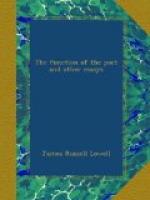The ideal in expression, then, deals also with the generic, and evades embarrassing particulars in a generalization. We say Tragedy with the dagger and bowl, and it means something very different to the aesthetic sense from Tragedy with the case-knife and the phial of laudanum, though these would be as effectual for murder. It was a misconception of this that led poetry into that slough of poetic diction where everything was supposed to be made poetical by being called something else, and something longer. A boot became “the shining leather that the leg encased”; coffee, “the fragrant juice of Mocha’s berry brown,” whereas the imaginative way is the most condensed and shortest, conveying to the mind a feeling of the thing, and not a paraphrase of it. Akin to this was a confounding of the pictorial with the imaginative, and personification with that typical expression which is the true function of poetry. Compare, for example, Collins’s Revenge with Chaucer’s.
Revenge
impatient rose;
He threw his blood-stained sword in thunder
down,
And,
with a withering look,
The war-denouncing
trumpet took,
And blew a blast
so loud and dread,
Were ne’er prophetic
sound so full of woe!
And
ever and anon he beat
The
doubling drum with furious heat.
“Words, words, Horatio!” Now let us hear Chaucer with his single stealthy line that makes us glance over our shoulder as if we heard the murderous tread behind us:
The smiler with the knife hid under the cloak.
Which is the more terrible? Which has more danger in it—Collins’s noise or Chaucer’s silence? Here is not the mere difference, you will perceive, between ornament and simplicity, but between a diffuseness which distracts, and a condensation which concentres the attention. Chaucer has chosen out of all the rest the treachery and the secrecy as the two points most apt to impress the imagination.
The imagination, as concerns expression, condenses; the fancy, on the other hand, adorns, illustrates, and commonly amplifies. The one is suggestive, the other picturesque. In Chapman’s “Hero and Leander,” I read—
Her fresh-heat blood cast figures in her
eyes,
And she supposed she saw in Neptune’s
skies
How her star wander’d, wash’d
in smarting brine,
For her love’s sake, that with immortal
wine
Should be embathed, and swim in more heart’s-ease
Than there was water in the Sestian seas.
In the epithet “star,” Hero’s thought implies the beauty and brightness of her lover and his being the lord of her destiny, while in “Neptune’s skies” we have not only the simple fact that the waters are the atmosphere of the sea-god’s realm, but are reminded of that reflected heaven which Hero must have so often watched as it deepened below her tower in the smooth Hellespont. I call this as high an example of fancy as could well be found; it is picture and sentiment combined—the very essence of the picturesque.




